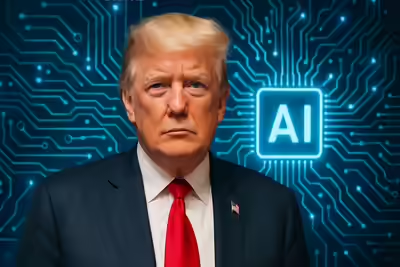
In a sweeping move to secure its dominance in artificial intelligence, the White House, under President Donald Trump, unveiled a detailed 26-page AI Action Plan on July 23. Framed as the start of a new “industrial, informational, and intellectual revolution,” this plan lays out a comprehensive strategy focused on innovation, infrastructure, and global leadership.
Powering AI Innovation: A New Era for American Ingenuity
The first focus of the plan is to supercharge technological development across the U.S. Key initiatives include:
Removing regulatory hurdles that limit private sector innovation, especially those concerning misinformation, DEI, and climate-based constraints.
Promoting open-source AI models and democratizing access to compute power for developers and researchers.
Strengthening collaborations with tech companies and expanding the National AI Research Resource (NAIRR).
AI adoption will also be encouraged across critical industries like healthcare, agriculture, defense, and energy, with military and intelligence services expected to regularly assess and expand their AI operations.
Supporting Workers and Future-Proofing the Job Market
Rather than replacing jobs, the plan envisions AI as a job-enhancing tool. To support this shift:
AI training will be embedded into K–12 and university curriculums.
Companies investing in workforce training will receive tax benefits.
Labor market dynamics will be tracked in real-time to spot trends and upskill as needed.
Retraining initiatives will be launched for industries likely to face automation.
Emerging fields such as robotics, autonomous vehicles, and drones will receive federal support via innovation grants and public-private partnerships.
Advancing AI for Science and Research
A core component of the plan involves using AI to accelerate scientific breakthroughs:
Funding will be provided for cloud-based laboratories to run large-scale simulations.
Open datasets will be released across domains like biology and chemistry.
A genome-sequencing initiative will analyze organisms on federal lands to boost biological AI modeling.
Research will be focused on improving AI robustness, safety, and explainability.
AI in Government: Smarter, Faster Public Sector
To modernize federal operations, a Chief AI Officers Council will be formed to guide AI deployment. Government actions will include:
Streamlining procurement for AI tools and systems.
Training federal employees in AI capabilities.
Identifying use cases across departments for efficiency gains.
The Department of Defense will take the lead with an AI proving ground, building systems for automation, emergency readiness, and secure decision-making.
Cybersecurity and AI Protection
The rise of AI also increases vulnerabilities. The U.S. plans to:
Launch a national AI Information Sharing and Analysis Center to coordinate threat intelligence.
Revamp cybersecurity protocols to handle AI-specific threats.
Enforce AI system assurance standards for reliability and safety.
Set up incident response systems tailored to AI deployments.
Building America’s AI Backbone
The plan’s second major pillar is about infrastructure. To sustain the AI boom, the government will:
Fast-track data center and semiconductor plant permits.
Use federal land for building compute and AI training facilities.
Restrict use of any foreign adversary-linked technologies in infrastructure.
Because AI needs massive power, the national grid will undergo upgrades to:
Improve transmission speed and stability.
Integrate advanced energy sources like nuclear fusion and geothermal.
Bringing semiconductor manufacturing back to the U.S. remains a top priority. Ongoing CHIPS Act efforts will be supported, and more skilled trade jobs like electricians and HVAC technicians will be created through training programs.
Leading Globally: AI Diplomacy and Security
Global leadership is the third and final pillar. The U.S. aims to:
Export the entire AI stack—from chips to governance—to allied nations.
Actively counter China’s influence in AI standard-setting.
Push U.S.-aligned values in global AI policy forums like the G7 and UN.
To back this leadership:
Export controls will be tightened.
AI chips will have location tracking to prevent misuse.
Semiconductor loopholes will be closed through secondary tariffs and product rules.
The U.S. will also enforce compliance globally through diplomatic and trade tools.
Biosecurity and Legal Readiness
As AI and biotech converge, the plan calls for strong safeguards:
Labs using federal funds must use safe DNA synthesis tools.
Systems will be deployed to detect malicious bioengineering attempts.
Legal frameworks will be updated to handle synthetic media and deepfakes.
Courts and regulators will be trained in AI-generated content law.
Conclusion: Charting the AI Future on America’s Terms
The U.S. AI Action Plan is not just a policy paper—it’s a strategic declaration. By focusing on innovation, infrastructure, and international influence, the U.S. is positioning itself to lead the world through the next AI revolution.
Whether in science, defense, governance, or the workforce, America is making clear that it doesn’t intend to follow—it intends to define the global AI landscape.

